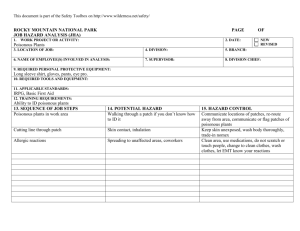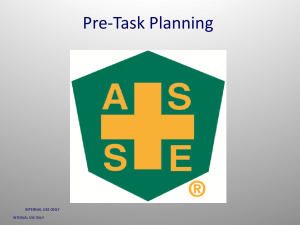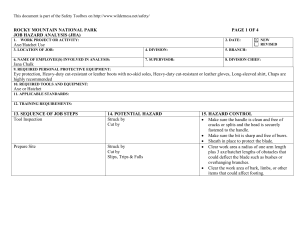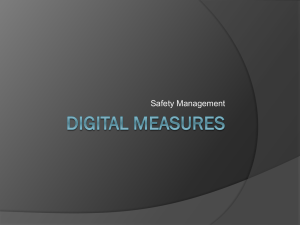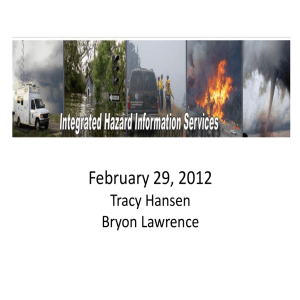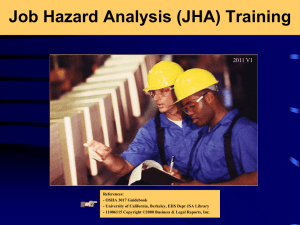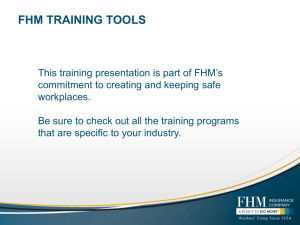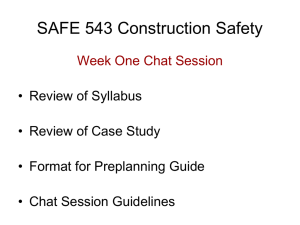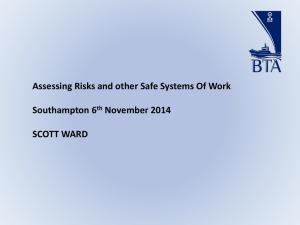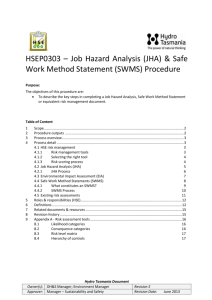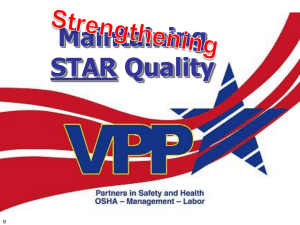Job Hazard Analysis Training
advertisement
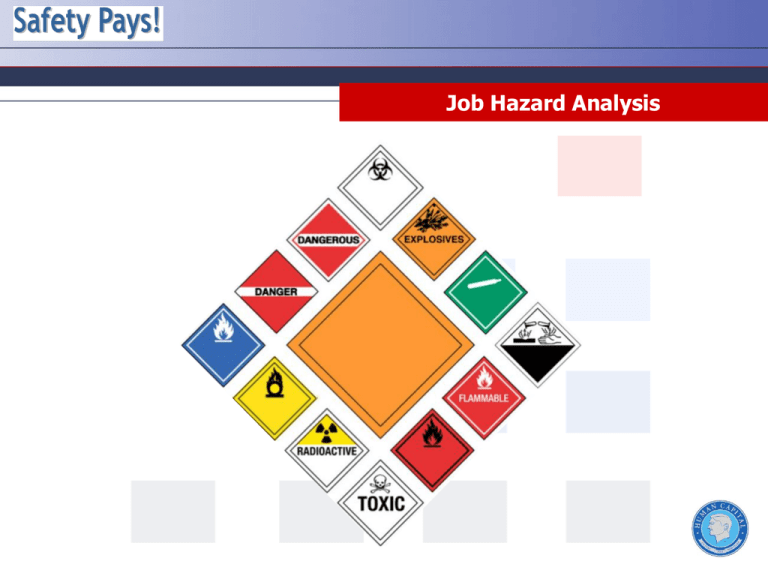
Job Hazard Analysis Disclaimer • This training material presents very important information. • Your organization must do an evaluation of all exposures, applicable codes and regulations, and establish proper controls, training, and protective measures to effectively control exposures and assure compliance. • This program is neither a determination that the conditions and practices of your organization are safe nor a warranty that reliance upon this program will prevent accidents and losses or satisfy local, state or federal regulations. • All procedures and training, whether required by law or not, should be implemented and reviewed by safety and risk management professionals, and legal counsel to ensure that all local, state and federal requirements are satisfied. Course Outline – Job Hazard Analysis 1. 2. 3. 4. 5. 6. 7. 8. 9. 10. Why use the JHA/Succeed Process? Example Projects Using the Job Hazard Analysis Steps to a Successful Safety Process Step 1: Identify Step 2: Train Step 3: Observe Step 4: Analyze Questions Summary Why Use the JHA/Succeed Process? Utilization of proactive tools enables : • • Increased awareness Adherence to controls This results in: • • Fewer incidents Lower associated costs 100 90 80 70 60 50 40 30 20 10 0 Example Projects Claims Costs $50,000.00 $40,000.00 $30,000.00 $20,000.00 $10,000.00 $0.00 MEDICAL $ INDEMNITY $ Manufacturer Example Projects Case Study Claims Cost Per Million Dollars in Payroll 1 25,000 20,000 15,000 (Before JHA) 10,000 2 5,000 0 1 Healthcare 2 Using the Job Hazard Analysis (JHA) What is a Job Hazard Analysis (JHA)? •JHAs help establish and properly document safety issues and procedures. •They outline the exposures or hazards so that controls are established. •They facilitate employee training that drives safer and more efficient work practices. •Organizations can utilize them to identify existing or potential job hazards, and determine the safest and most efficient way to perform the job. •They are the base point for training that must be given to the employee to make sure they do their job right. Using the Job Hazard Analysis (JHA) When is a JHA required? • Hazard assessments are required in all situations where there is a reasonable chance an employee could be injured. • In any work environment where personal protective equipment (PPE) is required. • For ensuring compliance on many OSHA standards, e.g. confined space entry, lock out/tag out, fall protection, etc. • As the main component of an effective behavior-based safety program as well as for OSHA’s Voluntary Protection Program. Steps To A Successful Safety Process There are four steps in the behavior based safety approach: 1. Identify potential or existing loss sources. • Determine the types of controls that are missing, or that need to be adjusted, and, make the necessary corrections. 2. Train employees on the hazards inherent in the job and how to utilize properly the controls that are in place, so that the job can be done correctly and safely. 3. Observe employees and the process in motion to look for deviations. • In the case of a deviation, the manager will quickly communicate corrective measures to the employees involved. 4. Analyze processes continuously for opportunities to improve them. These steps are in continual motion for any task in order to continually look for ways to improve processes. Step 1: Identify How can you identify loss sources? • Discuss safety in the workplace. Ask how injuries can occur. • Perform a Job Hazard Analysis (JHA) assessment. • Review loss history. What are loss sources? • Accidents have causes which are barriers to working safe. – Unsafe conditions: unguarded table saw – Unsafe acts: not wearing PPE – Unsupported tasks: tasks that can’t be completed safely • Review loss information records of past incidents and injuries to establish trends and patterns. Step 1: Identify What controls will prevent reoccurrences? • Develop solutions as a team with employee input. • Drill down to find the root cause for the loss source. • Enter the hazards and needed controls into the Job Hazard Analysis (JHA). • It is important that the manager make sure the root cause of the problem is established. This takes a thorough and in-depth investigation. Step 1: Identify Once the true root cause is found, fix any problems: • Remove the risk, e.g., tripping • Implement the modified/new process, e.g., correct job hazard. procedure. • Document corrective action in the Job Hazard Analysis program. Step 2: Train • Interview new employees with the JHA: – It sets a precedent for safety. – Provides discussion material on job. – Provides discussion material on hazards. – Enables assessment of safety attitude. • Train existing employees with the JHA: – Utilize at safety meetings. – Perform a monthly “One Step” refresher – Use to round out job function procedural training. Step 2: Train A Job Hazard Analysis example: Job Name: Over-Arm Panel Saw Hazard Assessment Prepared By: Date: 2/20/11 J. Smith Steps Hazards / Issues Job Requirement Working with lumber Exposure to falling materials, foot and head injuries - Wear safety shoes - Do not drop materials from elevated work Step 3: Observe Observe employees and processes: • Involve all staff. • Shadow the worker and make safety observations while they are performing their job. • Train all staff to routinely observe behaviors: – Mentor new employees. – Do team observations. – Communicate results and track change. – Focus on 100% adherence to Critical Safety Behaviors. – Tie to Safety Recognition Program. Step 3: Observe Here is an example Safety Observation Report for an Auction Driver job: Step 3: Observe Communicate findings promptly: • • Enter safety observations to identify areas needing attention and training. Identify the issue before an incident occurs! Solutions to change behaviors: • Retrain affected employees on unsafe or non-enabled tasks. • Assign worker with a safety coach. • Increase the frequency of safety observations. • Participate in team safety observations. • Implement procedural changes if necessary. • Present findings at a team safety meeting. Step 4: Analyze Use trending to focus on major loss sources: • Track “at-risk-behaviors” before they result in a claim. • Pinpoint areas that need attention within your organization. • Generate job descriptions, training program, and behavioral evaluation for each job or task. Questions Question 1: Multiple choice: Which of the following would not represent opportunities for workplace improvements for a loss prevention program? A. Workers not matched correctly to the job. B. Process procedures that are not current and inaccurate. C. Planning the summer picnic. D. Inadequate incident response supplies. E. Identification of a fall hazard. C. Planning the summer picnic. Questions Question 2: True or false: The JHA should be used in the new employee interview in order to set a precedent for safety expectations and awareness. A. True B. False A. True Questions Question 3: True or false: The first step of a successful safety process is to observe and communicate. A.True B.False B. False Summary Loss prevention programs are proactive management: • • • • Identify major and potential loss sources by knowing the hazards of each job task and correcting any issues. Train employees on any procedural, equipment, or facility changes. Observe employee behaviors and communicate results immediately with employees. Analyze, audit, and continually improve processes to assure system is effectively in place and fine tune process as needed. Job Hazard Analysis This form documents that the training specified above was presented to the listed participants. By signing below, each participant acknowledges receiving this training. Organization: Trainer: Trainer’s Signature: Class Participants: Name: Signature: Date: Name: Signature: Date: Name: Signature: Date: Name: Signature: Date: Name: Signature: Date: Name: Signature: Date: Name: Signature: Date: Name: Signature: Date: Name: Signature: Date: Name: Signature: Date: Name: Signature: Date: Name: Signature: Date: Name: Signature: Date: Name: Signature: Date:
